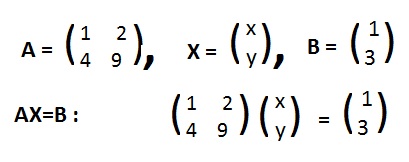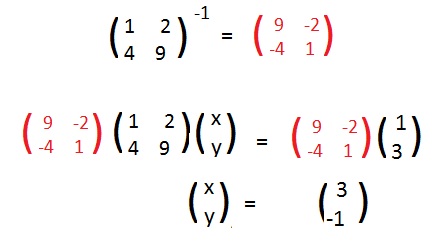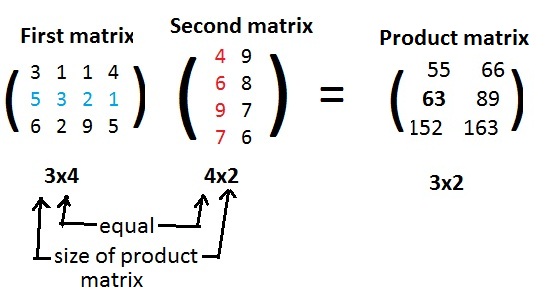

Row number in Column number in Dot product (→)⋅(↓) Location in Product Matrix
First Matrix Second Matrix
1 1 (3)(4) + (1)(6) + (1)(9) + (4)(7) = 55 55 in row 1, column 1
1 2 (3)(9) + (1)(8) + (1)(7) + (4)(6) = 66 66 in row 1, column 2
2 1 (5)(4) + (3)(6) + (2)(9) + (1)(7) = 63 63 in row 2, column 1
2 2 (5)(9) + (3)(8) + (2)(7) + (1)(6) = 89 89 in row 2, column 2
3 1 (6)(4) + (2)(6) + (9)(9) + (5)(7) = 152 152 in row 3, column 1
3 2 (6)(9) + (2)(8) + (9)(7) + (5)(6) = 163 163 in row 3, column 2

det(A) = a1a4 − a2a3
det(B) = b1b4 − b2b3
det(AB) = (a1b1 + a2b3)
(a3b2 + a4b4) −
(a1b2 + a2b4)
(a3b1 + a4b3)
=
a1b1a3b2 +
a1b1a4b4 +
a2b3a3b2 +
a2b3a4b4 −
a1b2a3b1 −
a1b2a4b3 −
a2b4a3b1 −
a2b4a4b3
=
a1b1a4b4 +
a2b3a3b2 −
a1b2a4b3 −
a2b4a3b1
=
a1a4b1b4 −
a1a4b2b3 −
a2a3b1b4 +
a2a3b2b3
=
(a1a4 − a2a3)(b1b4 − b2b3)
=
(det(A))(det(B)).
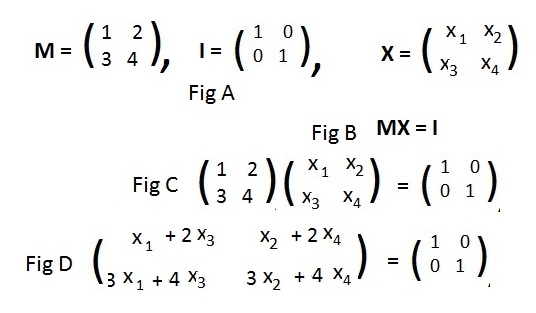 The matrix M is given in Fig A to the right. The inverse matrix of M exists because
The matrix M is given in Fig A to the right. The inverse matrix of M exists because
Matrix equality requires that all corresponding entries be equal. There are four equations in this case:
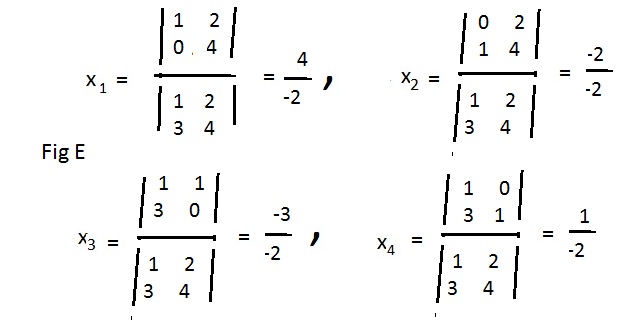 Therefore the solutions are:
Therefore the solutions are:
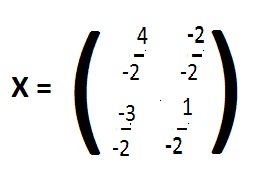
The computer calculates the adjoint
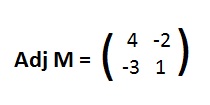
and then says to obtain the inverse divide the adjoint by Det M = -2. The results agree with X.
Intuitively speaking, the adjoint produces the numerators of the fractions, and the determinant value of the given matrix provides the denominators. For 3x3 a matrix, 9 linear equations must be solved to produce the adjoint. And for nxn matrices there are n2 equations that must be solved to compute the adjoint. The computer uses a different method to produce the adjoint, and does not solve any linear equations doing it. Nevertheless, the method involves much computation evaluating n2 determinants, which the computer does very fast and accurately.
